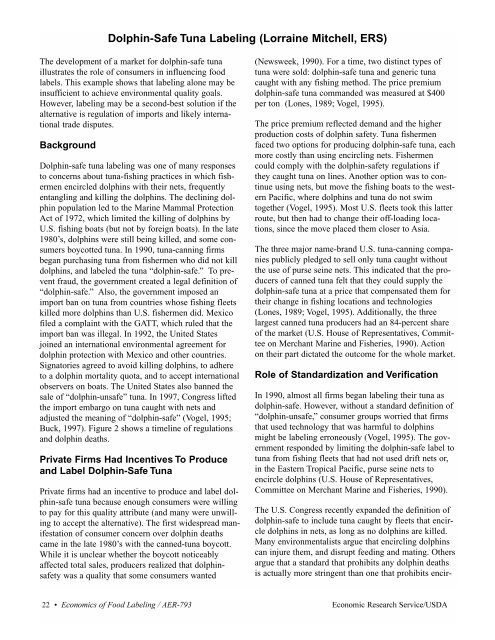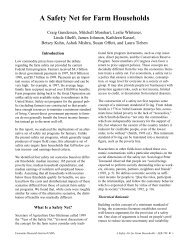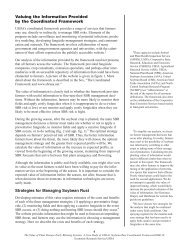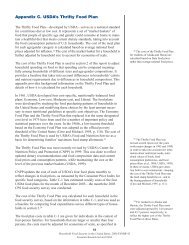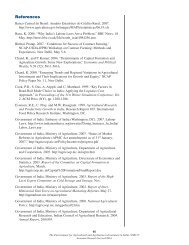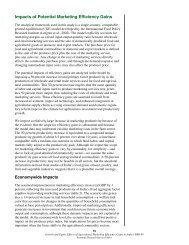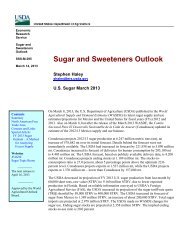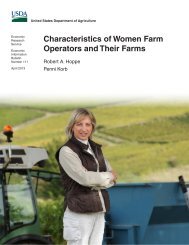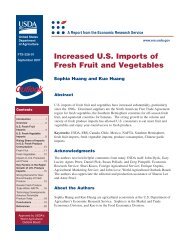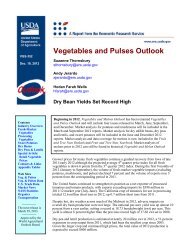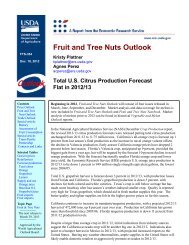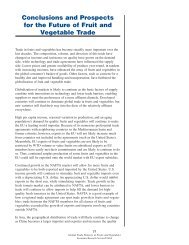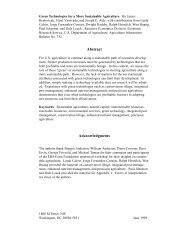Dolphin Safe Tuna Labeling - Economic Research Service
Dolphin Safe Tuna Labeling - Economic Research Service
Dolphin Safe Tuna Labeling - Economic Research Service
Create successful ePaper yourself
Turn your PDF publications into a flip-book with our unique Google optimized e-Paper software.
The development of a market for dolphin-safe tuna<br />
illustrates the role of consumers in influencing food<br />
labels. This example shows that labeling alone may be<br />
insufficient to achieve environmental quality goals.<br />
However, labeling may be a second-best solution if the<br />
alternative is regulation of imports and likely international<br />
trade disputes.<br />
Background<br />
<strong>Dolphin</strong>-<strong>Safe</strong> <strong>Tuna</strong> <strong>Labeling</strong> (Lorraine Mitchell, ERS)<br />
<strong>Dolphin</strong>-safe tuna labeling was one of many responses<br />
to concerns about tuna-fishing practices in which fishermen<br />
encircled dolphins with their nets, frequently<br />
entangling and killing the dolphins. The declining dolphin<br />
population led to the Marine Mammal Protection<br />
Act of 1972, which limited the killing of dolphins by<br />
U.S. fishing boats (but not by foreign boats). In the late<br />
1980’s, dolphins were still being killed, and some consumers<br />
boycotted tuna. In 1990, tuna-canning firms<br />
began purchasing tuna from fishermen who did not kill<br />
dolphins, and labeled the tuna “dolphin-safe.” To prevent<br />
fraud, the government created a legal definition of<br />
“dolphin-safe.” Also, the government imposed an<br />
import ban on tuna from countries whose fishing fleets<br />
killed more dolphins than U.S. fishermen did. Mexico<br />
filed a complaint with the GATT, which ruled that the<br />
import ban was illegal. In 1992, the United States<br />
joined an international environmental agreement for<br />
dolphin protection with Mexico and other countries.<br />
Signatories agreed to avoid killing dolphins, to adhere<br />
to a dolphin mortality quota, and to accept international<br />
observers on boats. The United States also banned the<br />
sale of “dolphin-unsafe” tuna. In 1997, Congress lifted<br />
the import embargo on tuna caught with nets and<br />
adjusted the meaning of “dolphin-safe” (Vogel, 1995;<br />
Buck, 1997). Figure 2 shows a timeline of regulations<br />
and dolphin deaths.<br />
Private Firms Had Incentives To Produce<br />
and Label <strong>Dolphin</strong>-<strong>Safe</strong> <strong>Tuna</strong><br />
Private firms had an incentive to produce and label dolphin-safe<br />
tuna because enough consumers were willing<br />
to pay for this quality attribute (and many were unwilling<br />
to accept the alternative). The first widespread manifestation<br />
of consumer concern over dolphin deaths<br />
came in the late 1980’s with the canned-tuna boycott.<br />
While it is unclear whether the boycott noticeably<br />
affected total sales, producers realized that dolphinsafety<br />
was a quality that some consumers wanted<br />
(Newsweek, 1990). For a time, two distinct types of<br />
tuna were sold: dolphin-safe tuna and generic tuna<br />
caught with any fishing method. The price premium<br />
dolphin-safe tuna commanded was measured at $400<br />
per ton (Lones, 1989; Vogel, 1995).<br />
The price premium reflected demand and the higher<br />
production costs of dolphin safety. <strong>Tuna</strong> fishermen<br />
faced two options for producing dolphin-safe tuna, each<br />
more costly than using encircling nets. Fishermen<br />
could comply with the dolphin-safety regulations if<br />
they caught tuna on lines. Another option was to continue<br />
using nets, but move the fishing boats to the western<br />
Pacific, where dolphins and tuna do not swim<br />
together (Vogel, 1995). Most U.S. fleets took this latter<br />
route, but then had to change their off-loading locations,<br />
since the move placed them closer to Asia.<br />
The three major name-brand U.S. tuna-canning companies<br />
publicly pledged to sell only tuna caught without<br />
the use of purse seine nets. This indicated that the producers<br />
of canned tuna felt that they could supply the<br />
dolphin-safe tuna at a price that compensated them for<br />
their change in fishing locations and technologies<br />
(Lones, 1989; Vogel, 1995). Additionally, the three<br />
largest canned tuna producers had an 84-percent share<br />
of the market (U.S. House of Representatives, Committee<br />
on Merchant Marine and Fisheries, 1990). Action<br />
on their part dictated the outcome for the whole market.<br />
Role of Standardization and Verification<br />
In 1990, almost all firms began labeling their tuna as<br />
dolphin-safe. However, without a standard definition of<br />
“dolphin-unsafe,” consumer groups worried that firms<br />
that used technology that was harmful to dolphins<br />
might be labeling erroneously (Vogel, 1995). The government<br />
responded by limiting the dolphin-safe label to<br />
tuna from fishing fleets that had not used drift nets or,<br />
in the Eastern Tropical Pacific, purse seine nets to<br />
encircle dolphins (U.S. House of Representatives,<br />
Committee on Merchant Marine and Fisheries, 1990).<br />
The U.S. Congress recently expanded the definition of<br />
dolphin-safe to include tuna caught by fleets that encircle<br />
dolphins in nets, as long as no dolphins are killed.<br />
Many environmentalists argue that encircling dolphins<br />
can injure them, and disrupt feeding and mating. Others<br />
argue that a standard that prohibits any dolphin deaths<br />
is actually more stringent than one that prohibits encir-<br />
22 • <strong>Economic</strong>s of Food <strong>Labeling</strong> / AER-793 <strong>Economic</strong> <strong>Research</strong> <strong>Service</strong>/USDA
Figure 2. Timeline of dolphin deaths and interventions<br />
Annual <strong>Dolphin</strong> Deaths<br />
500,000<br />
100,000<br />
18,000-16,000<br />
by U.S. boats<br />
28,000<br />
5,000<br />
1960’s<br />
1972<br />
1990<br />
1993<br />
Interventions and Legislation<br />
Marine Mammal Protection Act<br />
limits killing of dolphins by U.S. boats<br />
Late 1980’s Consumer boycott of tuna; U.S. Government begins<br />
pressuring other countries to improve fishing practices<br />
to save dolphins<br />
April<br />
October<br />
November<br />
1991<br />
1997<br />
<strong>Tuna</strong> producers announce dolphin-friendly<br />
practices and labeling of “dolphin-safe”<br />
U.S. enforces import ban on tuna from countries<br />
that kill more dolphins than the United States does<br />
<strong>Dolphin</strong> Protection Consumer Information Act<br />
regulates labeling of dolphin-safe characteristics<br />
Mexico files complaint with GATT, alleging that<br />
embargo and labeling legislation are illegal<br />
1992 International <strong>Dolphin</strong> Protection Agreement is<br />
signed. Sale of dolphin-unsafe tuna is banned<br />
Congress changes definition of dolphin-safe to allow<br />
tuna caught in nets, as long as no dolphins were killed;<br />
Congress lifts import embargo to allow boats with no<br />
observer aboard to use nets<br />
<strong>Economic</strong> <strong>Research</strong> <strong>Service</strong>/USDA <strong>Economic</strong>s of Food <strong>Labeling</strong> /AER-793 • 23
cling nets. Currently, two types of dolphin-safe tuna<br />
exist. The U.S. Department of Commerce certifies the<br />
new standard. The major canning companies and several<br />
grocery and restaurant chains have pledged to use<br />
only tuna that meets the older definition. Two different<br />
logos are in use, identifying different types of dolphinsafe<br />
tuna. Some nonprofit groups, like the Humane<br />
Society, maintain lists of processors and retailers who<br />
are adhering to the old standard.<br />
This new development illustrates the fact that standards<br />
may have to change as circumstances change. It also<br />
illustrates the potential pitfalls of government attempts<br />
to establish a standard in the presence of competing<br />
interests in the private sector. If consumers have one<br />
standard in mind, and tuna fleets and other countries<br />
have another, there is the potential for consumers to<br />
reject the government standard that effects a compromise<br />
between the two.<br />
Verification of labeled claims was another important<br />
third-party service provided by the government. <strong>Dolphin</strong><br />
safety is a credence attribute; it is difficult, if not<br />
impossible for consumers to detect fraudulent claims.<br />
Enforcement of the Marine Mammal Protection Act<br />
effectively verified label claims. Passage of the Act<br />
required observers on each U.S. boat to verify that dolphins<br />
and other marine mammals were not dying in<br />
large numbers. By counting dolphin deaths per boat<br />
each season, observers’ reports offered canners a reliable<br />
means of selecting tuna that meets a claim of no<br />
dolphin deaths.<br />
The Government’s Role – Considering<br />
Externality Costs and Trade Relations<br />
The active role the Federal Government played in<br />
establishing standards and verification for dolphin-safe<br />
tuna labeling came in recognition of the fact that tuna<br />
fishing practices imposed an externality cost. This cost,<br />
enumerated in dolphin deaths, was borne by those who<br />
value the preservation of the species. This cost was not<br />
reflected in tuna production costs or tuna prices.<br />
In devising an appropriate response to the externality<br />
(and to environmental groups who lobbied for legal<br />
solutions to dolphin mortality), policymakers had to<br />
consider the trade ramification of any policy response.<br />
The GATT ruled that the trade embargo was illegal.<br />
The effect of production on a resource (dolphins) outside<br />
U.S. borders did not give the United States the<br />
right to exclude imports. Also, the United States had<br />
not exhausted all other possibilities for saving dolphins.<br />
The <strong>Dolphin</strong>-<strong>Tuna</strong> Case is regarded by some as a<br />
GATT ruling overturning an environmental law that<br />
served as an effective trade barrier. However, the GATT<br />
ruled that the labeling law was legal.<br />
The trade dispute with Mexico under the GATT illustrates<br />
three points. First, when a country proposes a<br />
labeling regulation, costs and benefits may depend on<br />
interaction with similar laws (or lack thereof) enacted<br />
by trading partners. The labeling provision was challenged<br />
under the GATT, along with the import ban,<br />
because Mexico regarded the label as a barrier to trade.<br />
This suggests that each time a country’s firms label<br />
their goods in a way that its trading partners do not,<br />
there is the potential for a trade dispute, if the labels<br />
cause consumers to choose domestic over imported<br />
products. Second, mediating between domestic and<br />
international perspectives in establishing standards is a<br />
difficult process. Recent changes in the definition of<br />
dolphin-safe were enacted to appease partners in the<br />
International <strong>Dolphin</strong> Conservation Program, who<br />
wanted to be able to export tuna to the United States.<br />
These changes have not been accepted by all consumers.<br />
Third, if labeling is unlikely to violate international<br />
trade agreements, it may be the best policy<br />
response to social concerns. The GATT, the forerunner<br />
of the WTO, upheld the labeling provision because it<br />
did not prohibit the movement of goods, and was<br />
applied equally to foreign and domestic products<br />
(Vogel, 1995). We have seen that labeling is not a<br />
method that will guarantee achievement of social goals.<br />
However, some may regard it as a second-best solution<br />
if more stringent regulation of imports induces trading<br />
partners to file a WTO complaint.<br />
What Impact Did the Labels Have?<br />
The dolphin-safe label allowed consumers to signal<br />
their preferences for saving dolphins. But purchasing<br />
dolphin-safe tuna might still yield an environment in<br />
which many dolphins are killed despite consumers’<br />
willingness to pay to prevent those deaths. Some consumers<br />
might be willing to pay more than the dolphinsafe<br />
tuna price premium to protect dolphins. Others<br />
might be unwilling to pay any premium. As the latter<br />
group has no reason to take other consumers’ preferences<br />
over dolphin deaths into account, their purchases<br />
of low-cost tuna would support the production of tuna<br />
that incidentally yields dolphin deaths. Thus, the<br />
impact of the label on dolphin deaths depended on the<br />
number of consumers who were and were not willing<br />
to pay a premium. So, was labeling enough to reduce<br />
dolphin deaths to a level at which the willingness to<br />
24 • <strong>Economic</strong>s of Food <strong>Labeling</strong> / AER-793 <strong>Economic</strong> <strong>Research</strong> <strong>Service</strong>/USDA
pay by U.S. society, composed of all of different types<br />
of consumers, was equal to the additional cost?<br />
Answering the question is difficult because several different<br />
actions influenced dolphin deaths. The Marine<br />
Mammal Protection Act required fishing fleets to<br />
reduce their levels of incidental marine mammal mortality,<br />
to have an inspector on board, and to use only<br />
specific types of fishing technology. As a result, dolphin<br />
deaths dropped substantially long before labeling<br />
began.<br />
Since canneries were free to purchase tuna from either<br />
U.S. or foreign sources, the U.S. regulations were<br />
insufficient to assure consumers that they were purchasing<br />
dolphin-safe tuna. Vogel (1995) reports that<br />
between 1989 and 1991, dolphin deaths dropped further.<br />
In 1990, the boycott prompted canneries to switch<br />
to dolphin-safe tuna, allowing consumers to reveal their<br />
preferences for dolphin-safe tuna by buying more of it.<br />
However, when canneries began using the dolphin-safe<br />
label, the United States also pressured Mexico and<br />
other countries to change their fishing regulations and<br />
imposed a trade embargo against countries whose fishing<br />
fleets had high numbers of dolphin deaths. Since<br />
U.S. consumers were 50 percent of the canned tuna<br />
market, labeling could have had some independent<br />
effect, but it is difficult to state unequivocally whether<br />
the reduction in dolphin deaths was due to the labeling<br />
effort and resulting consumer pressure on tuna canneries<br />
and fishermen or to one of the government initiatives<br />
(see Buck, 1997). It is also impossible to know<br />
whether labeling alone, without all of the marine mammal<br />
legislation, would have resulted in an adequate<br />
reduction in dolphin mortality.<br />
In addition to the social benefits, there were also social<br />
costs to the government’s actions. It has already been<br />
noted that many fishing fleets moved their operations to<br />
the western Pacific. Indeed, foreign fishing fleets,<br />
which could not always afford to fish so far away from<br />
home ports, argued that they bore very high costs as a<br />
result of the embargo and the pressure to change fishing<br />
techniques (Vogel, 1995). Additionally, the government<br />
bears the substantial costs of having an observer<br />
on each boat, which reduces the verification costs for<br />
producers. Again, however, because the labeling, consumer<br />
activism, the Marine Mammal Protection Act,<br />
and the embargo all took place around the same time, it<br />
is unclear whether or not the labeling legislation by the<br />
government was primarily responsible for these social<br />
costs. The Congressional Budget Office estimated that<br />
labeling legislation, negotiating with foreign governments,<br />
and making the sale of dolphin-unsafe tuna illegal<br />
would cost about $6 million per year (U.S. House<br />
of Representatives, Committee on Merchant Marine<br />
and Fisheries, 1990).<br />
Another possible cost of the dolphin-safe label is any<br />
impact of labeling and the change in production practices<br />
on tuna prices. The fact that “dolphin-unsafe” tuna<br />
was essentially driven out of the market after these<br />
changes means that all tuna consumers were forced to<br />
purchase dolphin-safe tuna. <strong>Tuna</strong> is a relatively inexpensive<br />
source of protein (and is included in the U.S.<br />
Department of Agriculture’s food and education program<br />
for Women, Infants, and Children (WIC)). An<br />
increase in tuna prices as a result of new production<br />
methods and labeling could impose costs on lowincome<br />
households that may be unwilling (and/or<br />
unable) to pay for dolphin safety. As a result, a redistribution<br />
of welfare from low-income consumers to highincome<br />
consumers could occur. In the dolphin-safe<br />
tuna example, however, prices did not obviously<br />
increase after the change in production practices and<br />
labeling. The longrun trend in the price of tuna has<br />
actually been slightly downward, with prices decreasing<br />
from $2.35 per pound in 1980 to $2.12 in 1999<br />
(nominal dollars). It is, however, difficult to decipher<br />
whether or not the change in tuna production practices<br />
contributed to or damped this trend.<br />
In spite of the general fall in price, U.S. per-capita tuna<br />
consumption peaked in 1989 and has fallen since.<br />
Some ascribe this drop in sales to poor advertising, others<br />
to the lower quality tuna available in the western<br />
Pacific (Ferraiuolo, 1998). If labeling and the shift in<br />
production practices had an effect on tuna prices, quality,<br />
or consumption, analysts would need to include<br />
these effects in a complete cost-benefit analysis of the<br />
dolphin-safe label.<br />
<strong>Economic</strong> <strong>Research</strong> <strong>Service</strong>/USDA <strong>Economic</strong>s of Food <strong>Labeling</strong> /AER-793 • 25


